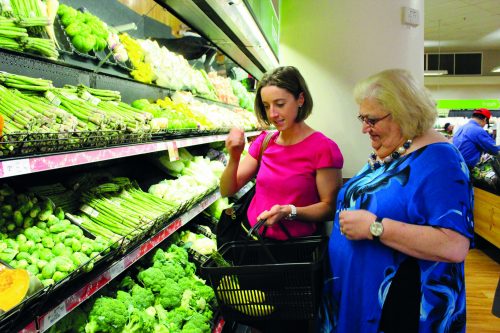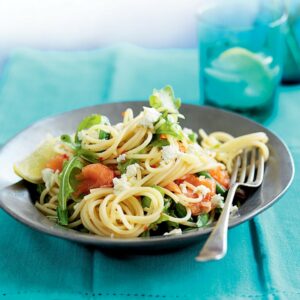
Being diagnosed with type 2 diabetes can be overwhelming at first — but it needn’t be. Nutritionist Zoe Wilson spent some time with an enthusiastic reader to demonstrate how just a few simple steps can drastically improve your health.
The growing number of people with type 2 diabetes in New Zealand is staggering. Around 150,000 New Zealanders have been diagnosed with type 2 diabetes and a similar number are estimated to be living with the disease, but don’t know it. So what do you do if you are diagnosed? To show you that it isn’t as hard to manage as you may think, nutritionist Zoe Wilson is helping HFG reader, Ann Smith, to control her diabetes and to lose the extra weight that Ann has battled with over the past 15 years.
What is type 2 diabetes?
Type 2 diabetes accounts for about 90 per cent of diabetes cases in New Zealand. Type 2 diabetes occurs when the insulin made by your pancreas doesn’t work as well as it should, resulting in more glucose (sugar) in the blood than normal. Over time, a high blood glucose level (BGL) can lead to complications such as heart and kidney disease and blindness, so it is essential to get things under control.
Type 2 diabetes is usually a result of both genetic and lifestyle factors and usually affects older adults, although an increasing number of younger people, even children, are being diagnosed. In fact, type 2 diabetes is New Zealand’s most rapidly growing chronic disease.
The good news is that in many cases, type 2 diabetes can be prevented, delayed or improved with a healthy diet, active lifestyle and weight-loss (if you are overweight). While diagnosis can seem overwhelming and frightening, with good information, careful management and the know-how we’re about to share, you can make living with diabetes easier and even enjoy foods you thought were off the menu.
Symptoms
- Excessive thirst and urination
- Tiredness and lethargy
- Increased appetite and gradually putting on weight
- Slow-healing cuts, itching and skin infections
- Blurred vision, headaches, dizziness and mood swings
Factors putting you at risk of pre-diabetes or type 2 diabetes
- Being overweight or obese (a waist measurement less than 80cm for women and less than 94cm for men is ideal; risk is higher above 88cm for women and 102cm for men)
- Being physically inactive
- High cholesterol
- High blood pressure
- Smoking
- A family history of type 2 diabetes and/or heart disease
HFG reader Ann Smith
Ann is a 62-year-old, recently retired grandmother of two who was diagnosed with type 2 diabetes eight years ago but “hasn’t taken it seriously” until recently, when she was prescribed insulin to control her blood sugar levels.
Ann also suffers from high cholesterol, arthritis and obstructive sleep apnoea. Her weight is currently 103kg, with a 37.8 body mass index (BMI). The healthy weight range for most people is a BMI of between 18.5 and 24.9.
Ann’s weight has increased gradually over the past 15 years (about two kilos each year) due to a combination of lifestyle, diet and medication that increased her appetite. Six months ago, Ann hit her highest weight of 113kg and then decided to do something about it. She was motivated by the fear that she might not be able to help look after her grandkids or be around to watch them grow up.
Ann’s husband John is very supportive of her improving her health — he, too, has type 2 diabetes so he’s also keen to learn. Ann and John shop together and John has become quite the budding chef since his retirement! Although Ann is retired she is still very busy during the week looking after her grandkids and volunteering at her local community centre. She is active most days and always on the go! For the past five years, Ann has been doing an hour of cardio exercise and weight-training at her local gym three days a week but no other planned exercise.
Step 1: Analyse your current diet
Ann’s day on a plate
Zoe asked Ann to explain what her typical daily diet is currently like so Zoe could see where they could make small changes.
Breakfast
- 1 cup of tea with trim milk and a bowl of Special K Advantage with low-fat yoghurt or
- 1-2 slices of café-style raisin toast or
- 2-3 days a week Ann skips breakfast and grabs a chocolate bar when out running errands
Morning tea
- Nothing or
- 1 cup of coffee with trim milk or
- 1 large flat white (full cream)
Lunch
- Nothing or
- 1 cup of tea and 1 sandwich made with 2 slices of multigrain bread, 2 slices of cheese or ham and pickle or
- 1 chocolate bar when on the go (2-3 a week)
Afternoon tea
- 1 cup of tea and something sweet that John has made eg. a scone with jam and cream or
- 1 lemon tart
Dinner
- Homemade steak and mushroom or mince and kidney meat pie with steamed vegetables or
- Baked chicken breast stuffed with ricotta and tomato with steamed vegetables or
- A meat and vegetable casserole or
- Spaghetti bolognese (no extra vegetables) or
- ‘Masterchef’ pizzas: homemade and judged by her granddaughter
Fluids
- 3-4 glasses diet soft drink
- 2-3 glasses of water
- 2 cups of tea
- 4-5 cups of coffee (up to 2-3 from a café)
Zoe’s analysis
Ann generally chooses great products to stock her pantry and eats relatively balanced meals when at home, although she could increase the proportion of veges on her plate. The major problems I see for Ann are:
- An irregular eating pattern which leads to poor decision-making when she is on the run, and irregular patterns in her blood sugar levels
- Large portion sizes at main meals (particularly dinner)
- High-energy snacks that are contributing significantly to her daily energy intake
- ‘Drinking energy’ — a high intake of kilojoules from coffee and tea (and minimal water)
- An exercise routine that hasn’t changed for five years which needs a shake-up to keep her body guessing.
Step 2: Set goals
Ann’s goals
The next step was to set some clear goals to help Ann take the first steps towards better health.
“Together we worked out some specific goals for Ann to focus on so that she had an action plan when she went home,” says Zoe. “This breaks the task into bite-sized pieces that will help to keep her motivated. We also worked out a sample day for Ann, with examples of better choices at main meals and snacks including appropriate portion sizes.” Together, Ann and Zoe developed six goals:
- Try not to skip meals. Plan your day so you know when and what you will eat, and don’t get caught out.
- Before eating, ask: “Am I really hungry?” If the answer is yes, then ask yourself: “What do I really feel like?” Choose a small portion of the best quality if it is a treat food you feel like, and savour it. If the answer is no, then ask yourself: “Why do I want to eat?” and “What else can I do instead?”
- Slow down! Take at least 20 minutes to eat your meal, putting your knife and fork down in between bites. Chew chew chew, taste, and enjoy it!
- Aim for the ‘ideal plate’ at lunch and dinner (see below)
- Aim to walk twice a week (in addition to current gym sessions)
- Try to drink fewer kilojoules – choose water first!
Step 3: Make healthier choices
The shopping trolley makeover
On a supermarket tour, Zoe points out to Ann the easy swaps she can make to help improve her diet.
Old trolley
While Ann had some great basics in her trolley of old (fresh fruit and vegetables and low-fat yoghurt), she also tended to pick products that satisfied her sweet tooth such as a (chocolate) Aero bar and toasted muesli — items with extra energy that would contribute to her weight. Pictured (left)(DO I KEEP THIS IN?) are some of Ann’s supermarket items, some of which were swapped (right) to help improve her diet.
New trolley swaps
To reduce the amount of energy (but keep the satisfaction) in Ann’s trolley a few easy swaps (that still suited her) were made.We swapped:
- Bürgen Wholemeal & Seeds toast bread for Bürgen Soy Lin sandwich, a smaller slice, saving 203kJ per serve (2 slices).
- Sanitarium Cluster Crisp Vanilla Almond for Sanitarium Natural Muesli Fruit & Grains, saving 120kJ, 3.3g fat, 0.5g sat fat, and gaining 1.6g fibre per ½ cup (50g) serve.
- Pams Lite Coconut Cream for Carnation Light & Creamy Coconut Flavoured Evaporated Milk. Although light coconut cream is better than regular coconut cream, the Carnation option saves 155kJ, 10.9g fat and 9.4g sat fat per 100ml.
- Wattie’s Baked BeaNZ for Wattie’s Lite Baked Beans to save 170kJ, 5.6g sugar and 315mg sodium in a half can serve.
- Huntley & Palmers Somerset Original crackers for Huntley & Palmers Original Mixed Grain Wholegrain Crackers to go with some cheese before dinner occasionally, or with lunch instead of bread. Comparatively, two of these crackers save 1.3g fat, around 1g sat fat and 55mg sodium, and add around 1g fibre from the whole grains.
- Aero bar for an individual Sante bar at the checkout for a smaller chocolate hit. The Aero bar might say two serves but if we’re by ourselves it’s likely to be only one! Save 311kJ, 3.7g fat and 2.9g sat fat.
Step 4: Try this at home
How you can do this at home
Zoe’s tips for successful change and making changes stick:
- Pick a small change of action to focus on until you’ve turned it into a habit. For example: “I will try to eat breakfast every morning”. Once you are doing it regularly, you can work on another change.
- Swap something you are doing already for something a little healthier. For example: “I will choose a small trim flat white instead of a large full-fat flat white.”
- Try to make every meal healthier rather than change the food you eat entirely. Reduce the amount of fat, sugar and salt added in your food by choosing lean meat, reduced-fat dairy, no-added-salt ingredients and cooking with non-stick pots and pans so there is no need to add lots of oil.
- Make sure you choose goals that are achievable. If you don’t happen to reach your goal, you will make yourself feel guilty and be less likely to keep going. This is a life-long process so you need to be kind to yourself.
- When setting goals use encouraging words such as “I will try to…” or “at least…” Then if you do more, you will feel great for going above and beyond!
7 golden rules for eating with type 2 diabetes
The good news is that the diet recommendations for those with type 2 diabetes are the same as for the general population: a healthy, balanced and varied diet.
- Eat regular meals and snacks throughout the day.
- Each day aim for two serves of fruit and at least three serves of vegetables — more is even better.
- Follow the quarter-quarter-half ideal plate model for meals: one-quarter higher-fibre, lower-GI carbohydrates (eg. breads, cereals, rice, pasta and legumes), one-quarter lean protein (eg. lean meat, fish, legumes or eggs) and one-half vegetables or salad.
- Include two to three serves of low-fat dairy each day.
- Try to reduce the amount of high-fat, (particularly saturated fat), and high-sugar foods such as takeaways, biscuits, cakes and pastries. Also try to limit the amount of salt in your diet.
- Drink plenty of water. Aim for 1.5-2L each day.
- Have no more than two to three standard alcoholic drinks a day (for women and men respectively), if you choose to drink at all, and have at least two alcohol-free days a week.
“I guess I haven’t really taken [my diabetes] seriously before and know that I have to take drastic action.” — Anne
Did you know? ‘Diabesity’ is the term used to explain the strong link between diabetes and obesity. An Australian study on diabetes found that participants who were obese were four times more likely to develop type 2 diabetes than those with a BMI of between 19 and 24.
www.healthyfood.com










